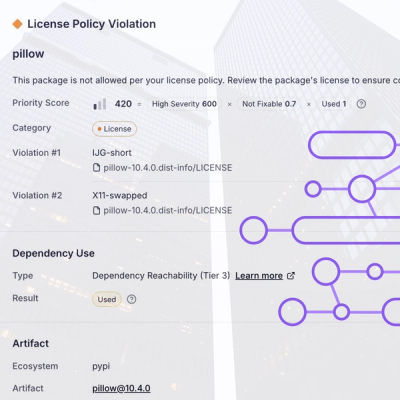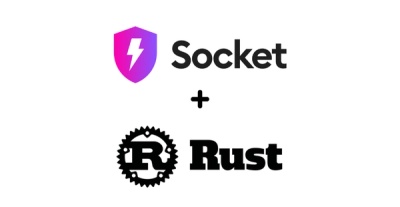
Research
/Security News
Critical Vulnerability in NestJS Devtools: Localhost RCE via Sandbox Escape
A flawed sandbox in @nestjs/devtools-integration lets attackers run code on your machine via CSRF, leading to full Remote Code Execution (RCE).

A least recently used (LRU) cache backed by Redis, allowing data to be shared by multiple Node.JS processes. API inspired by node-lru-cache.
var redis = require('redis').createClient(port, host, opts);
var lru = require('redis-lru');
var personCache = lru(redis, 5); // up to 5 items
personCache.set('john', {name: 'John Doe', age: 27})
.then(() => personCache.set('jane', {name: 'Jane Doe', age: 30}))
.then(() => personCache.get('john'))
.then(console.log) // prints {name: 'John Doe', age: 27}
.then(() => personCache.reset()) //clear the cache
var bandCache = lru(redis, {max: 2, namespace: 'bands', maxAge: 15000}); // use a different namespace and set expiration
bandCache.set('beatles', 'john, paul, george, ringo')
.then(() => bandCache.set('zeppelin', 'jimmy, robert, john, bonzo'))
.then(() => bandCache.get('beatles')) // now beatles are the most recently accessed
.then(console.log) // 'john, paul, george, ringo'
.then(() => bandCache.set('floyd', 'david, roger, syd, richard, nick')) // cache full, remove least recently accessed
.then(() => bandCache.get('zeppelin'))
.then(console.log) // null, was evicted from cache
Works both with node_redis and ioredis clients.
npm install redis-lru
max: Maximum amount of items the cache can hold. This option is required; if no
other option is needed, it can be passed directly as the second parameter when creating
the cache.namespace: Prefix appended to all keys saved in Redis, to avoid clashes with other applications
and to allow multiple instances of the cache.maxAge: Maximum amount of milliseconds the key will be kept in the cache; after that getting/peeking will
resolve to null. Note that the value will be removed from Redis after maxAge, but the key will
be kept in the cache until next time it's accessed (i.e. it will be included in count, keys, etc., although not in has.).score: function to customize the score used to order the elements in the cache. Defaults to () => new Date().getTime()increment: if true, on each access the result of the score function is added to the previous one,
rather than replacing it.All methods return a Promise.
set(key, value, maxAge): set value for the given key, marking it as the most recently accessed one.
Keys should be strings, values will be JSON.stringified. The optional maxAge overrides for this specific key
the global expiration of the cache.get(key): resolve to the value stored in the cache for the given key or null if not present.
If present, the key will be marked as the most recently accessed one.getOrSet(key, fn, maxAge): resolve to the value stored in the cache for the given key. If not present,
execute fn, save the result in the cache and return it. fn should be a no args function that
returns a value or a promise. If maxAge is passed, it will be used only if the key is not already in the cache.peek(key): resolve to the value stored in the cache for the given key, without changing its
last accessed time.del(key): removes the item from the cache.reset(): empties the cache.has(key): resolves to true if the given key is present in the cache.keys(): resolves to an array of keys in the cache, sorted from most to least recently accessed.values(): resolves to an array of values in the cache, sorted from most to least recently accessed.count(): resolves to the number of items currently in the cache.By using a custom score function and the increment option, one can turn the cache
into a least frequently used (LFU), where the items that have been accessed more times
(rather than most recently) are preserved:
var redis = require('redis').createClient(port, host, opts);
var lru = require('redis-lru');
var bandLfu = lru(redis, {max: 2, score: () => 1, increment: true});
bandLfu.set('beatles', 'john, paul, george, ringo')
.then(() => bandLfu.get('beatles')) // accessed twice
.then(() => bandLfu.set('zeppelin', 'jimmy, robert, john, bonzo'))
.then(() => bandLfu.set('floyd', 'david, roger, syd, richard, nick')) // cache full, remove least frequently accessed
.then(() => bandLfu.get('zeppelin'))
.then(console.log) // null, was evicted from cache
Each item in the cache is stored as a regular key/value in Redis. Additionally, a ZSET is used to keep an index of the keys sorted by last-accessed timestamp.
Requires Redis 3.0.2 or greater, since it uses the XX option of ZADD.
FAQs
redis-backed LRU cache
We found that redis-lru demonstrated a not healthy version release cadence and project activity because the last version was released a year ago. It has 1 open source maintainer collaborating on the project.
Did you know?

Socket for GitHub automatically highlights issues in each pull request and monitors the health of all your open source dependencies. Discover the contents of your packages and block harmful activity before you install or update your dependencies.

Research
/Security News
A flawed sandbox in @nestjs/devtools-integration lets attackers run code on your machine via CSRF, leading to full Remote Code Execution (RCE).

Product
Customize license detection with Socket’s new license overlays: gain control, reduce noise, and handle edge cases with precision.

Product
Socket now supports Rust and Cargo, offering package search for all users and experimental SBOM generation for enterprise projects.